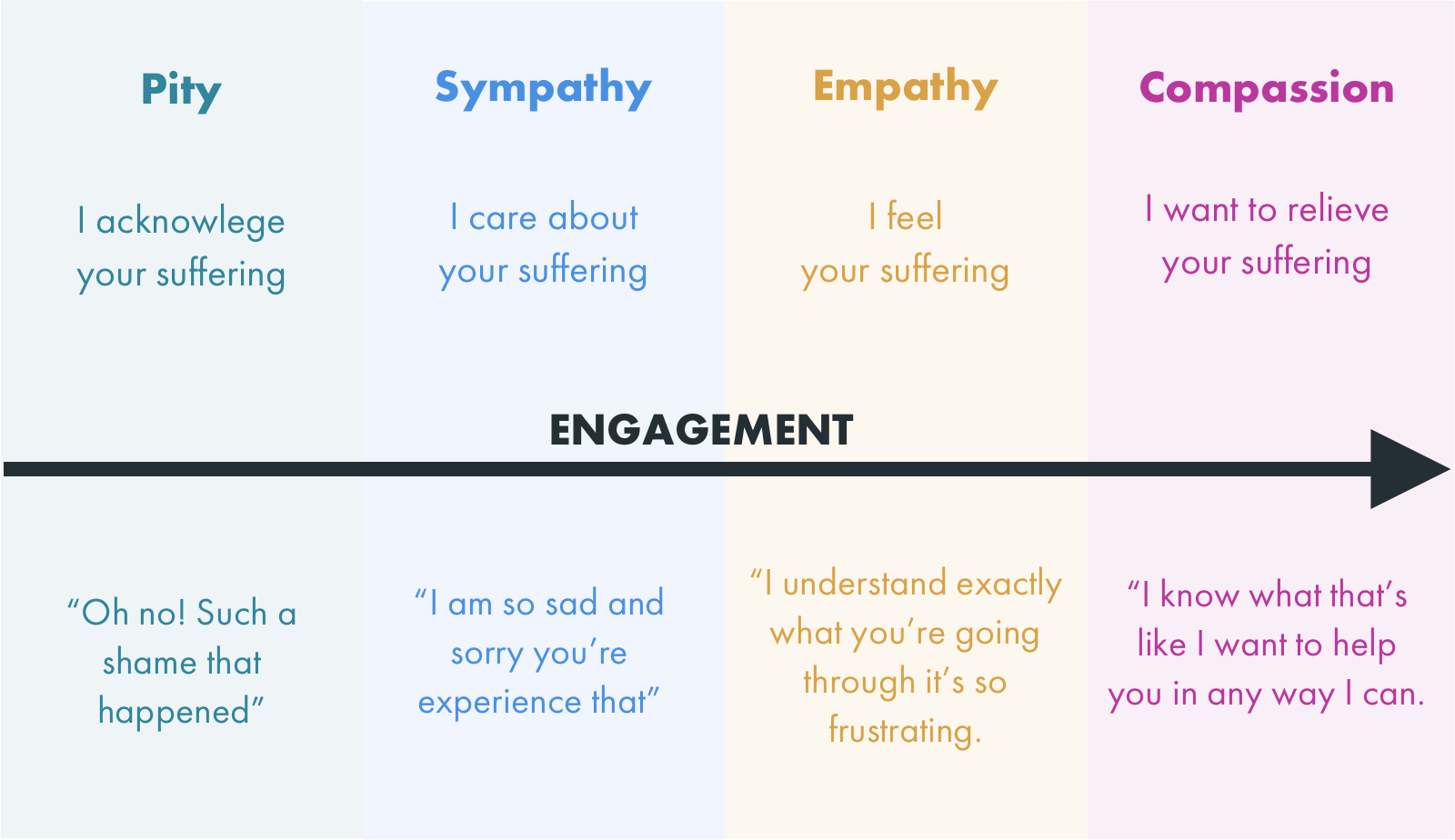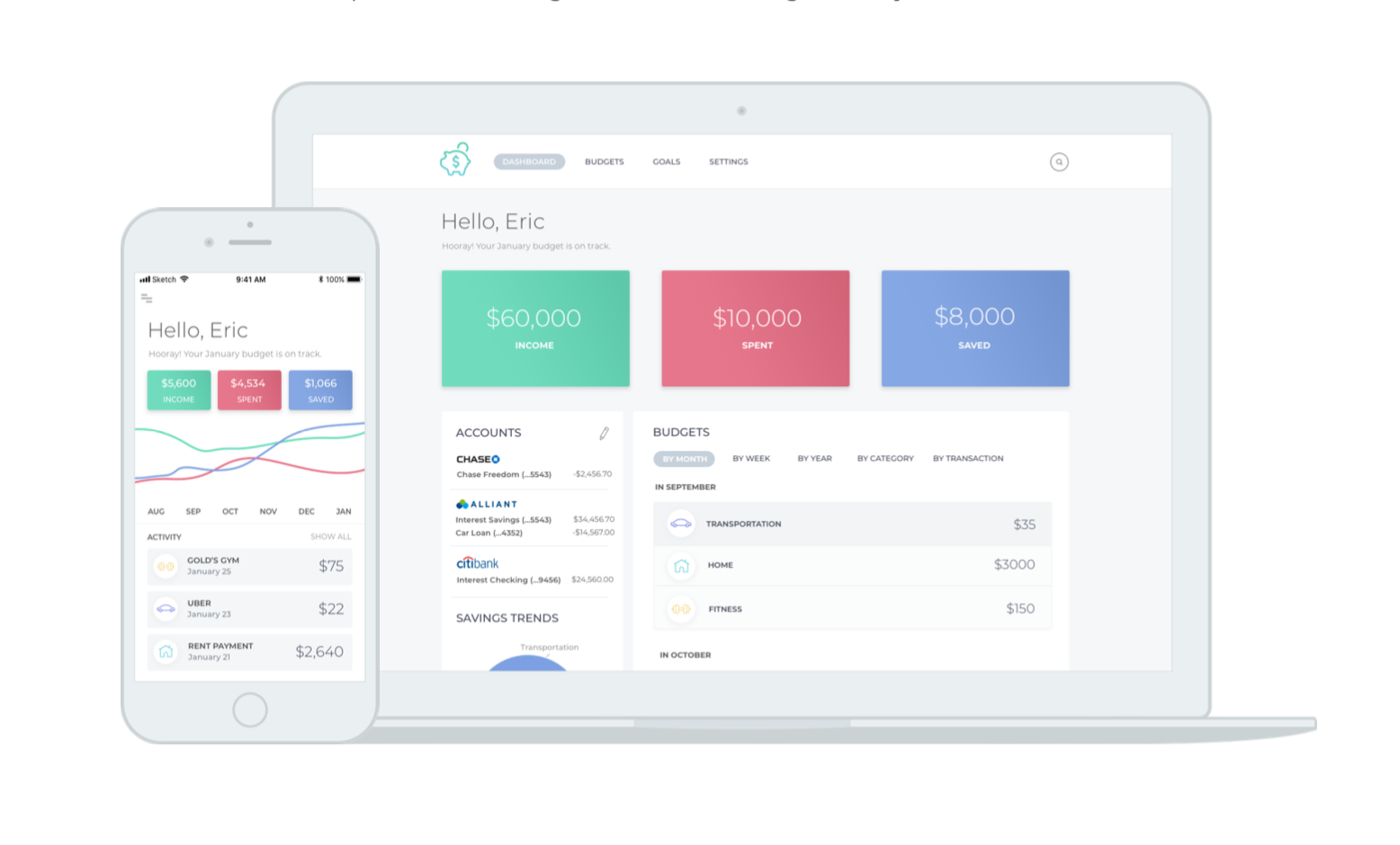We hear the term 'user empathy' floating around the design world a lot these days. But are we really clear on what exactly that means? How many of us are really confusing empathy with sympathy or even pity and are we doing it right?
As designers, user experience researchers and user interface designers, we sometimes get so lost in the doing; conducting our research, compiling it, synthesizing it into deliverables like persons and trying to come across as though we care, that we lose sight of the actual feeling aspect of what it actually means to be empathic.
What exactly is Empathy?
Let's be clear on what Empathy is and is not. Empathy is not sympathy nor pity nor compassion.
Pity - Usually suggests a kindly, but sometimes condescending, sorrow aroused by the suffering or ill fortune of others. It tends to have a negative connotation in which you think less of the individual, their situation or suffering.
Sympathy - Used to convey commiseration or feelings of sorrow for someone else who is experiencing misfortune. You feel bad for them but may not know what's its like to be in their shoes.
Empathy - Used to refer to the capacity or ability to imagine oneself in the situation of another, experiencing the emotions, ideas, or opinions of that person or perhaps conjuring up a similar experience that has happened to you. Seeing things from the point of view of the other by truly imagining being in their position and trying to feel what they are feeling.
Compassion - Is associated with an acknowledgment and experience of, caring about and active desire to alleviate the suffering of another.

Intention is everything
The concepts above all have to do with degrees of caring, engagement and the intention behind it.
Pity is the most detached and distant and often carries a sense that the suffering is acknowledged but looked down upon. Sympathy has a different level of intent in which you may really care to hear about the other's suffering and feel sorry for the other. Empathy goes a step further into engaging with and imagining the suffering and feeling it for yourself through your emotions. Compassion which is the most engaged, builds on all of these concepts but leaves you wanting to truly be with the suffering of another and relieve that suffering in some way.
Empathy does not always have to be associated with bad things either. You can also understand how happy someone feels and feel it too, as with a contagious laugh or smile.
What does it mean to be empathic to our users?
Many times through our UX research we come to feel a great deal of sympathy for our users, but we may fall short of empathy because we are not really trying to tap into the experience of the other, either through imagination or actively reliving our own similar experience.
Even after we feel that we understand the user holistically through our research, even after we've gained a lot of knowledge and data about our user and can sympathize with them, even though we call our research and our objectives user-centric, that still does not necessarily make us empathic.
Empathy is an exercise that we get better at over time by being clear about our intentions and consistent with our practice.
How can we truly become more mindful and empathic designers of experiences and interfaces?
The first step is to start to become mindful of our own intentions with each thought and action we take and then practice going deeper into our engagement with self and other.
Mindful User Surveys and Interviews

If we are about to conduct our first interview or survey you can center yourself and set an intention. Such as "I want to feel relaxed and make the user feels comfortable. If I am relaxed they will feel relaxed". Now try practicing your interview questions in a natural and relaxed manner with the intention of truly encompassing that feeling. Do whatever you need to do to center yourself, be it meditating, going for a run, eating a nice a meal, being in nature. This energy will carry over into your interactions with others.
Awareness of self first, then others. Internal before external.
Creating Mindful Personas

If we are creating a user persona we can have the intention that we want to be as accurate as we can and we want to paint a true picture of the user and imagine ourselves living their life or having their experience. Almost like an actor preparing for a role. Once we've created the persona, why not role play as if you are them, imagine what their home might look like, smell like, really rely on your imagination and get in tune with your feelings about it. Don't just think you understand the persona, try and imaging feeling what the persona might be experiencing.
Designing Mindful Interfaces

If we are designing the User interface and the business people say they want the text bigger, even though that throws off your visual hierarchy and balance, rather than be upset with them try and put yourself in their shoes and imagine all the research and reasoning they must have gone through in order to arrive at that conclusion. Recognize that we've also gone through a lot of research and reasoning and studying our craft to arrive at size 16px, but now we must put our ego aside, step into their shoes for a minute and feel what they must be feeling. Then we can take the action, with the intention of choosing a font size that works for everyone by both calmly and clearly defending our decisions and openly listening to feedback without judgement.
Empathy takes practice
We start by taking an honest look at our motivations (be it good, or bad, self-servicing or other-serving) then dropping the judgment and giving ourselves a break, then we decide the intention that we want to set for ourselves and how we show up. We practice softening our hearts to the people and the situations at hand as they arise through each interaction. Each unfolding moment is a chance to set a new intention and choose a new way of being. You can and will fail a million times and that doesn't matter, each moment is just another chance and so it goes until one day we truly feel what the suffering of our users might be like, our co-workers and our bosses and then we can start to look at ways we can help, heal or lighten that suffering through compassion.
The concept of empathy and compassion is at the heart of many eastern philosophies and practices but it seems in the west that many of us show empathy by approximation. We think we feel it, based on the idea of a concept but not the lived experience of a practice. We are filled with knowledge but not wisdom, insight but not experience. Being mindful of ourselves and our interactions with others is what gets us from the later to the former.
We are filled with knowledge but not wisdom, insight but not experience. Being mindful of ourselves and our interactions with others is what gets us from the later to the former.
The experience of sympathy, empathy vs compassion
How many times have we been on the phone with a customer service representative, something has gone wrong and we turn to them for help. What we often get is sympathy, and they may say things like "well I'm sorry about that ma'am but theres nothing we can do". They may show us sympathy but it's less common that they will show empathy. Ever so often a company really acknowledges that they understand what we must be feeling, maybe they'll say "that's awful that our service went down when you needed it at a crucial moment, I hate that feeling when you have only an hour to make your credit card payment and the system doesn't let you login. It's the worst." You get a sense that that person feels empathy for you, they understand what's running through your mind and what you must be feeling and are able to express it in a way that makes you feel heard. Now for the company that goes the step further they might say. "How can we fix this? Would it help if we gave you a refund for the month that you paid for or perhaps we can give you a discount on your next months bill?" This next step of wanting to relieve the user's suffering is called compassion.
You can see how this takes an intention of the provider and may also require money from the company. That's why it's so important that we weave empathy practice and compassionate action into every step of our product development. If we decide early on that we want to provide a compassionate response to our users problems then we must leave room in the budget for creating that company culture, organizational structure, designer mindset and allocate the needed resources to be able to extend that compassion.
Moving from Empathy to Compassion
Even though I'm presenting these ideas, I by no means have mastered empathy. I am certainly not empathic when someone cuts me off on the way to work. I am certainly not empathic when my husband beats me in a video game. But I have cultivated enough self-awareness to recognize this in myself and enough resolve to mindfully chip away at reprogramming my patterns and reflexes.
Whenever I play a co-op game with my husband and we would lose, I'd call myself an idiot for being lousy and worthless and then flame at my teammates for not pulling their weight and then get pissed off at the game because it lagged at a crucial moment, I would swear to myself that I will train 10x harder so I wouldn't loose next time.
As I trained harder and still lost, I noticed my body getting tense every-time we played and my mood getting aggressive and that I would sweat more. I came to the shocking realization that I may not be a profession gamer I started to reassess and redefine my goals. Instead of making an external goal to train harder and win, I made it my internal goal to simply make it through this game without saying anything derogatory to myself (self-compassion). The intention being that I want to express love to myself instead of displeasure with or hatred of. If I could do that, then no matter what the outcome I would consider it a win. The next time, I made it my goal to not flame at anyone else in the game. The intention being empathy, I tried to imagine myself as one of the players that I thought really messed up the game for me, maybe their parents were yelling at them and they got distracted, maybe their kid was crying, I try to imagine how bad that must feel and start to practice empathy. Then finally I decided that I would do whatever I can to take full responsibility for any lost games (in a self-compassionate way) and vow to do whatever it takes to carry my team. With the intention of showing compassion to others form a place of truly wanting to relieve their suffering.
Anything can be an exercise in empathy and compassion
This is the kind of daily practice in the minutiae that it takes. First at the individual level we must become mindful of our thoughts and our emotions and then cultivate kindness and compassion towards ourselves. Then we can start to extend that outwards to our relationships and our users.
As designers, the work of conducting surveys, creating personas and designing websites is the easy part, practicing and living our intentions moment by moment as we do these things is the hard part. But that is precisely how we can cultivate true user empathy.
Challenge
I'm not prescribing that we all become lovey dovey, hippies (although would that be so bad?). It doesn't mean we won't get angry, feel wronged, disagree with people or feel hurt. It simply means becoming aware of the feelings thoughts and emotions we have and noticing how we tend to normally react when things happens. Being aware of how we are, gives us the chance to decide how we want to be. The rest is up to us.
Being aware of how we are, gives us the chance to decide how we want to be.
If we are able to practice empathy consistently and with the right intention, is it possible to reach compassion for our users?
This is my challenge to myself as a mindful designer and human and the challenge I would like to extend to you all.
Share your mindful design ideas with us on Twitter #mindfuldesign @designerupco. Let's spread the word and the work of empathy and push towards becoming more compassionate makers.

